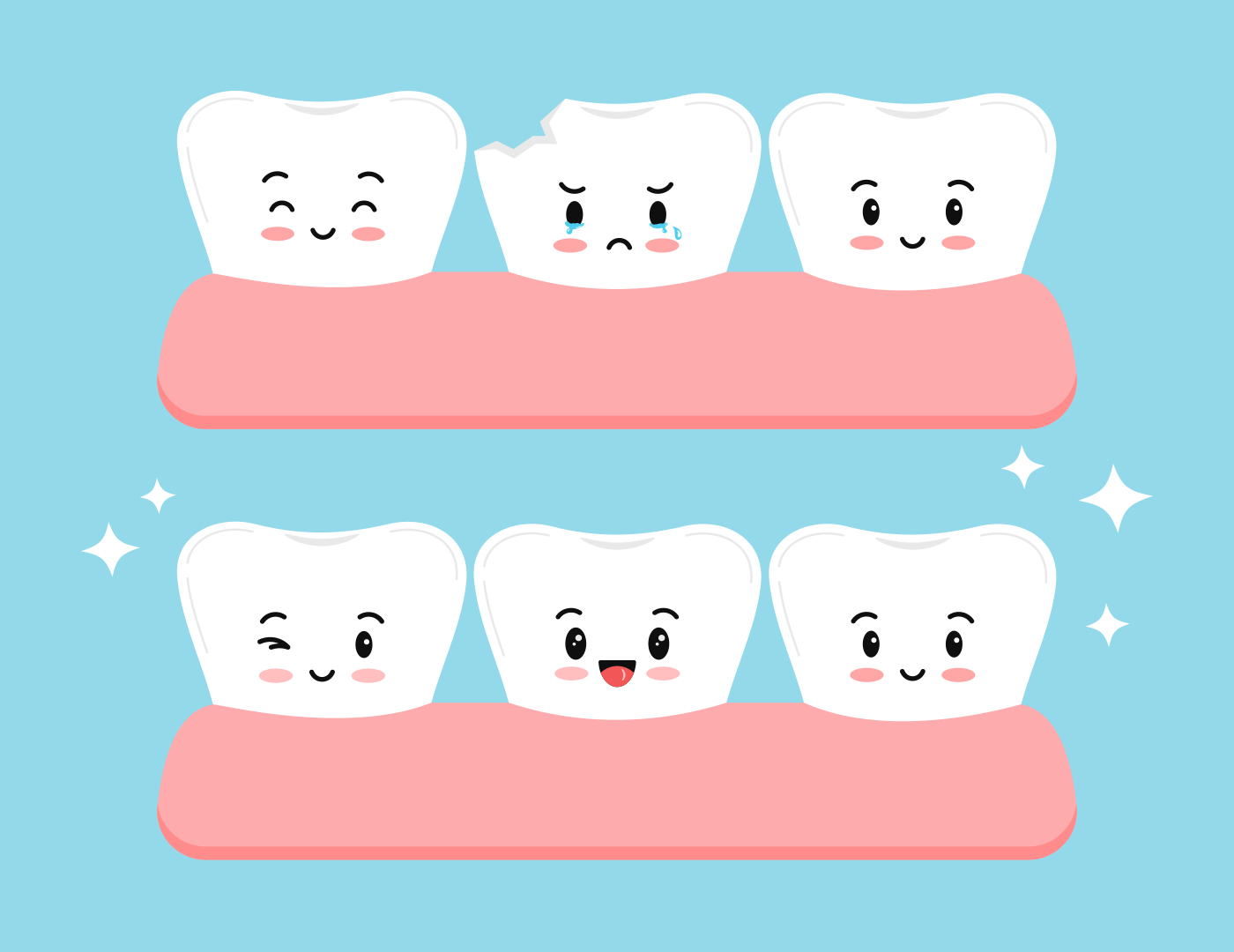Chipped Tooth? Learn About Root Canal Therapy and Other Treatment Options

A chipped tooth is a common dental problem that can happen to anyone. It can be caused by various factors, such as trauma, tooth decay, or biting down on hard objects. If left untreated, a chipped tooth can cause pain, sensitivity, and even infection. Fortunately, there are several treatment options available, including root canal therapy.
In this article, we will discuss the different root canal therapy options available for a chipped tooth, their benefits and risks, as well as tips on how to prevent chipping a tooth.
Causes of a Chipped Tooth
A chipped tooth can happen due to various reasons, including:
- Trauma to the mouth: This can be caused by a fall, accident, or sports injury.
- Biting down on hard foods or objects: This can include hard candy, ice, or even pens.
- Tooth decay: Decay weakens the tooth structure and makes it more susceptible to chipping.
- Weakened tooth enamel: This can be caused by acid erosion from acidic foods or drinks or from teeth grinding.
- Dental restorations: Old or poorly-fitted dental fillings or crowns can also weaken the tooth structure and cause it to chip.
Signs and Symptoms of a Chipped Tooth
The signs and symptoms of a chipped tooth can vary depending on the severity of the chip. Some common signs and symptoms include:
- Sharp pain when biting or chewing
- Sensitivity to hot or cold temperatures
- Visible damage or missing tooth fragment
- A rough or jagged edge on the tooth
- Swelling or tenderness in the gums
Diagnosing a Chipped Tooth
If you suspect that you have a chipped tooth, it’s essential to see a dentist for a diagnosis. Your dentist will perform a dental examination and may also take dental X-rays to evaluate the extent of the damage. Based on the diagnosis, your dentist will recommend the appropriate treatment.
Treatment Options for a Chipped Tooth
A chipped tooth can cause discomfort and impact your ability to eat and speak normally. Fortunately, there are several treatment options available to repair a chipped tooth.
Root Canal Therapy
Root canal therapy is a treatment option for a chipped tooth when the chip is deep enough to expose the tooth’s pulp. The pulp is the soft tissue that contains the nerves and blood vessels in the tooth. When the pulp is exposed, it can become infected, leading to further complications.
Explanation of the Procedure:
During a root canal, the dentist will remove the damaged pulp, clean and disinfect the tooth’s root canals, and fill them with a special material. The tooth is then sealed with a filling or crown to protect it from further damage.
When it’s Necessary:
Root canal therapy is necessary when the chip has exposed the pulp, causing pain, sensitivity, or infection. The dentist will determine if a root canal is necessary by performing a dental exam and taking X-rays.
Step-by-Step Process:
The root canal procedure typically involves the following steps:
- Local anesthesia to numb the area around the tooth
- Creating an opening in the tooth to access the pulp
- Removing the damaged pulp and cleaning the root canals
- Filling the root canals with a special material
- Sealing the tooth with a filling or crown
Aftercare and Recovery:
After a root canal, you may experience some discomfort and sensitivity for a few days. Your dentist may recommend over-the-counter pain medication or prescribe antibiotics to prevent infection. You should avoid chewing on the treated tooth until the permanent filling or crown is placed.
Dental Bonding
Dental bonding is a cosmetic treatment option for a chipped tooth that involves applying a tooth-colored resin to the damaged area.
Explanation of the Procedure:
During the dental bonding procedure, the dentist will apply a conditioning liquid to the tooth’s surface, followed by the tooth-colored resin. The resin is then shaped and polished to match the natural appearance of the surrounding teeth.
When it’s a Suitable Option:
Dental bonding is a suitable option for minor chips and cracks in the teeth that do not expose the pulp.
Step-by-Step Process:
The dental bonding procedure typically involves the following steps:
- Local anesthesia may be used to numb the area around the tooth
- Cleaning and preparing the tooth’s surface
- Applying a conditioning liquid to the tooth’s surface
- Applying the tooth-colored resin and shaping it to match the surrounding teeth
- Curing the resin with a special light
- Polishing the tooth to a smooth finish
Aftercare and Recovery:
After dental bonding, you should avoid eating hard or sticky foods for at least 24 hours. The bonded area may be sensitive for a few days. Good oral hygiene practices, including brushing and flossing regularly, can help prolong the bonding’s lifespan.
Dental Crown
Dental crowns, also known as “tooth caps,” are dental restorations that are designed to cover a damaged or weakened tooth. They are commonly used to protect a tooth that has undergone significant decay or trauma and cannot be restored with a simple filling.
Explanation of the Procedure
The dental crown is placed over a damaged or decayed tooth to restore its size, shape, strength, and improve its appearance. The crown covers the entire visible portion of the tooth above the gum line.
When it’s Necessary
A dental crown may be necessary in the following situations:
- To protect a weak tooth from breaking or to hold together parts of a cracked tooth
- To restore a tooth that is already broken or severely worn down
- To support and cover a tooth that has a large filling or has undergone root canal therapy
- To improve the appearance of a misshapen, discolored, or badly stained tooth
- To cover a dental implant or hold a dental bridge in place
Step-by-Step Process
The dental crown procedure typically involves the following steps:
- Consultation and Examination: The dentist will first examine your teeth and gums and take X-rays to assess the condition of the tooth and determine if a dental crown is the right treatment for you.
- Tooth Preparation: The tooth is prepared by removing the outer layer of the tooth to make room for the crown. This may involve filling in any cavities or decayed areas and shaping the tooth to fit the crown.
- Impression: An impression of the tooth is made using putty or digital scanning technology, which is sent to a dental laboratory to create a custom-made crown.
- Temporary Crown: While the permanent crown is being made, a temporary crown is placed over the tooth to protect it.
- Crown Placement: When the permanent crown is ready, the temporary crown is removed and the new crown is cemented onto the tooth.
Aftercare and Recovery
After getting a dental crown, it’s important to practice good oral hygiene to keep the tooth and surrounding gums healthy. This includes:
- Brushing your teeth twice a day and flossing daily
- Avoiding hard or sticky foods that may damage the crown
- Visiting the dentist regularly for checkups and cleanings
- Contacting the dentist if the crown feels loose or causes discomfort
Dental Veneers
Dental veneers are thin, custom-made shells that are placed over the front surface of teeth to improve their appearance. They are made of porcelain or composite resin and are permanently bonded to the teeth. The procedure involves removing a thin layer of enamel from the front surface of the tooth to make room for the veneer. The veneer is then custom-made to fit the tooth and color-matched to blend in with surrounding teeth.
When it’s a Suitable Option:
Dental veneers are a suitable option for individuals with teeth that are stained, chipped, or misaligned. They can also be used to close gaps between teeth or to lengthen worn down teeth.
Step-by-Step Process:
- Consultation and Examination: Your dentist will examine your teeth to determine if dental veneers are the best option for you. They may also take x-rays or make impressions of your teeth.
- Preparation: A small amount of enamel will be removed from the front surface of the tooth to make room for the veneer.
- Impression: An impression of the prepared tooth will be taken, and sent to a dental laboratory to create a custom veneer.
- Temporary Veneer: A temporary veneer will be placed on the tooth while the custom veneer is being made.
- Bonding: The custom veneer will be permanently bonded to the tooth using dental cement.
- Follow-Up: You will be scheduled for a follow-up appointment to ensure that the veneer is properly fitted and functioning.
Aftercare and Recovery:
After the procedure, it is recommended to avoid chewing on hard objects or biting your nails. Brush and floss regularly, and visit your dentist for regular check-ups.
Tooth Extraction:
Tooth extraction is the removal of a tooth from its socket in the jawbone. It can be a simple extraction or a surgical extraction, depending on the condition of the tooth.
When it’s Necessary:
Tooth extraction is necessary when a tooth is severely damaged, infected, or impacted (unable to emerge from the gum). It may also be necessary to make room for orthodontic treatment.
Step-by-Step Process:
- Numbing the Area: Local anesthesia will be administered to numb the area around the tooth.
- Loosening the Tooth: The dentist will use a special tool called an elevator to loosen the tooth in the socket.
- Extraction: The dentist will use forceps to grasp the tooth and gently rock it back and forth to remove it from the socket.
- Cleaning the Socket: The dentist will clean the socket to remove any debris or infection.
- Stitches: If necessary, the dentist will place stitches to close the socket.
- Follow-Up: You will be given post-operative instructions and scheduled for a follow-up appointment to monitor healing.
Aftercare and Recovery:
After the procedure, it is recommended to avoid smoking, using a straw, or spitting forcefully. Bite on gauze to control bleeding, and apply an ice pack to reduce swelling. Follow your dentist’s instructions for pain management and care of the extraction site.
Choosing the Right Treatment Option
When it comes to treating a chipped tooth, there are several factors to consider in choosing the right treatment option. Some of these factors include the cost of treatment, the severity of the chip, the location of the tooth, and the patient’s oral health history.
The cost of treatment can be a significant factor for many patients. Dental bonding is typically the most affordable option, while root canal therapy and dental crowns tend to be more expensive. It’s important to discuss your options with your dentist and your insurance provider to determine what treatment options are covered and what your out-of-pocket expenses will be.
The severity of the chip can also impact the recommended treatment. Minor chips may be treatable with dental bonding or veneers, while more extensive damage may require a dental crown or root canal therapy.
The location of the chipped tooth is another important factor. A chip in a front tooth may require a different approach than a chip in a back molar, as front teeth are more visible and may require a more aesthetic solution.
Finally, the patient’s oral health history is an important consideration. Patients with a history of dental decay or gum disease may be more prone to developing a chipped tooth, and may require a more extensive treatment plan to address underlying issues.
Prevention of a Chipped Tooth
While accidents happen, there are steps you can take to reduce your risk of chipping a tooth. Maintaining good oral hygiene by brushing twice a day, flossing regularly, and visiting the dentist for routine check-ups can help keep your teeth strong and healthy.
If you participate in sports, wearing a mouthguard can help protect your teeth from trauma. Avoid chewing on hard foods or objects, such as ice or pens, and seek treatment for any existing dental issues, such as decay or gum disease.
Risks and Complications
Like any dental procedure, there are risks and complications associated with treatment for a chipped tooth. Root canal therapy, in particular, can be associated with complications such as infection or damage to surrounding teeth. It’s important to discuss the risks and benefits of each treatment option with your dentist before making a decision.
FAQs
What should I do if I chip my tooth?
If you chip your tooth, it’s important to see a dentist as soon as possible to determine the extent of the damage and the best course of treatment. In the meantime, you can rinse your mouth with warm water and use a cold compress on your cheek to help reduce swelling.
How painful is a root canal?
The level of pain experienced during a root canal varies depending on the individual and the extent of the damage to the tooth. However, with modern anesthesia techniques, most patients report little to no pain during the procedure.
Will I need to take time off work after treatment?
The amount of time you will need to take off work after a root canal will depend on your individual situation. In general, most patients can return to work or normal activities the same day as the procedure, but some may need to take a day or two to recover.
How long does a root canal take?
The length of a root canal procedure can vary depending on the complexity of the case, but most can be completed within one to two hours. Your dentist can provide a more specific estimate based on your individual needs.
Can a chipped tooth heal on its own?
Unfortunately, a chipped tooth cannot heal on its own. While small chips may not require immediate treatment, larger chips or fractures can leave the tooth vulnerable to decay, infection, and further damage. It’s important to see a dentist as soon as possible to determine the best course of treatment for your individual situation.
Conclusion
A chipped tooth can be a painful and distressing experience, but with the right treatment, you can restore your smile and your oral health. If you’ve recently chipped a tooth, Access Dental is here to help you restore your smile and oral health. We offer root canal treatments to save damaged teeth and prevent further decay or infection.
Don’t wait to seek treatment – contact us today to schedule an appointment and discuss your options for restoring your tooth. Our team of experienced dentists will work with you to provide the best possible care and ensure your comfort throughout the procedure. Don’t let a chipped tooth cause you pain and distress – trust Access Dental to help you achieve a healthy, confident smile.



